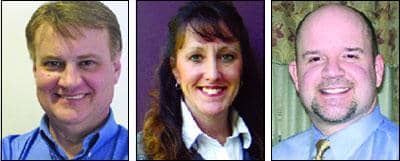Dually Credentialed RCPs: Traitors or Expanding Patient Care Opportunities?

Why did you become a respiratory therapist? Did you consciously choose respiratory therapy as a profession, or did you fall into it because it was health-related and not nursing?
I could not wait to enter the profession; in fact, I left high school a year early in order to reach my goal even faster. As a candy striper during high school, I worked in a number of different areas of the hospital so that I could check out different health career opportunities.
I loved working in hematology. The director taught me how to read differentials under the microscope because I was so eager to learn (much to the consternation of the Sister who ran the laboratory and just wanted me to run errands). But as much as I was fascinated by diagnosing illnesses, I worried about the lack of regular contact with patients and their families. Then I heard about a department called “Respiratory Therapy” and asked if I could volunteer there. I spent a day with the department director. I learned that as an RT, I could work in the most critical areas of the hospital with the sickest patients and their families. Doctors not only listened to what the department director said; many asked for his suggestions about treatments and ventilator settings. He was a respected professional. I subsequently spent many hours volunteering in the department—running errands, delivering equipment, and learning all I could about the field.
Choosing A Career
I decided on respiratory therapy as a career one Sunday afternoon when there was a commotion in obstetrics. A baby had been born prematurely, and a transport van was on the way to pick her up and take her to the medical center over an hour away. As I pressed my nose against the glass window looking into the nursery, I saw that the respiratory therapy director was in charge. He had experience caring for preemies, and the pediatricians and nursery nurses respected his knowledge and trusted him to guide the infant’s care until the transport team arrived. While they would not let me into the area, I watched, transfixed, as this respiratory therapist saved that infant’s life. I decided that was the career I wanted.
The next week, I did some research and found out that one of the top RT schools was in New York—where I lived—at Upstate Medical Center in Syracuse. I picked up the phone and called the program director, Carl Wiezalis (today, the immediate past president of the American Association for Respiratory Care [AARC]), to ask about the program. To make a long story short, my parents took me to Upstate for an interview. Carl was impressed with my knowledge of the field and my enthusiasm for becoming a respiratory therapist and he accepted me into the program. I graduated 2 years later and was awarded the “outstanding graduate” award for my class. I was one of the first 6,000 people registered in the United States.
That was more than 20 years ago. Today, I am dually credentialed as both a registered respiratory therapist and a registered nurse. Have I turned my back on the respiratory therapy profession by getting another credential? I suppose that is for others to decide. I do find it interesting that I have never heard it suggested that a respiratory therapist whose second credential is from medical school is a traitor to the profession. Is the problem when respiratory therapists get a second credential, or is it when they become nurses?
Core Values
The fact is that the foundation of my success as a clinician, educator, and consultant is my respiratory therapy education. Carl Wiezalis personifies professionalism, and because he introduced me to health care and was my first professional role model, I developed a core set of values that have been my rudder for more than 20 years. Among those values: place the patient first, commit to a lifetime of learning, strive for excellence, and widen your sphere of influence whenever you can.
Those core values helped me decide to go back to school and get a nursing degree 5 years after I graduated from Upstate. I loved my work as a respiratory therapist, but I felt there was more I could do. When I first attended nursing school, the role of the respiratory therapist was far more limited than it is today. I wanted to get more involved with the families of my patients and patient teaching, and to care for the whole patient. I did not want to do assembly-line treatments anymore and be reprimanded because I spent time teaching patients and families about their diseases and not producing enough “units of work” per shift.
Opportunities Available
So, I became an RRT, RN. My first job out of nursing school was in home care, taking care of kids requiring ventilators at home. I had specialized in pediatrics as an RT, and there I was using all of my RT education and very little of my nursing education. But my RN degree got me in the home care door both literally and figuratively. For the 2 years I worked in high-tech home care, I was able to make modifications to ventilator settings, teach parents about caring for their children, and develop comprehensive, multidisciplinary care plans in conjunction with a team of professionals including pharmacists and registered dietitians. I was essentially an RT in nurse’s clothing. In my mind, I was not abandoning the field of respiratory care, but instead, expanding it to a broader role that allowed me to use all of my skills and knowledge and get my agency reimbursed for the care I directed and provided.
Since then, I have taught in respiratory therapy programs and in nursing school. I have written more than 100 articles in the professional literature, and am most well known in the nursing community for writing about respiratory topics. Is that because of my excellent nursing education? No. It is a direct result of my respiratory therapy knowledge base. My goal is to teach nurses about the fine points of caring for respiratory patients that they may not learn anywhere else, such as interpreting pulse oximetry readings with an understanding of the oxyhemoglobin dissociation curve. I have written more articles about chest drainage than any other nurse. Did I learn about chest drainage in nursing school? No, and neither did most of my nursing colleagues—that is why the demand is so high. Whenever the opportunity arises in my writing, I stress the importance of nurses working as teammates with respiratory therapists. I tell nurses not to dare touch ventilator controls unless they work in a place where there is no respiratory therapist on-site. My RN title allows me to use the language of nursing for credibility while I remain a strong advocate for respiratory therapists.
I have worked as a board-certified emergency department (ED) nurse for the past 12 years. Am I good at procedural sedation because of my nursing education? Of course not. It was my respiratory therapy education that taught me how to skillfully monitor a patient’s cardiopulmonary status. With the advent of capnography technology that allows routine monitoring of end-tidal CO2 in spontaneously breathing patients, I am now an advocate of shifting procedural sedation from a nursing procedure to one carried out by RTs. When my former RT students work with me in the ED as colleagues now, I advocate for their role as the respiratory experts. When they ask me to start a treatment or measure a peak flow for them because they are busy upstairs, I tell them, “Get down here now. People in this department need to see you; you need to talk to them and be the expert. If they see me doing a respiratory procedure, they’ll think any nurse can do it…and that could put you out of a job!”
My most recent opportunity to use my nursing credentials to advocate for respiratory therapists has been as the liaison from the AARC to the nursing community. In turn, the American Association of Critical-Care Nurses has named me their liaison to the AARC. My dual credentials have allowed me to be in a position to build bridges between the professions—not to mark out the boundaries for turf wars.
When a prominent critical care nursing journal suggested in an editorial that nurses should take over the management of ventilators a few years back, I wrote a pointed letter to the editor. In it, I said:
“[Respiratory therapists] are critically important members of the team that enhances the care of the critically ill patient, just like the nutritional support team or the pharmaceutical consultants we rely on…. It is unrealistic and unwise to expect the nurse to be an all-knowing expert in every area. Today and for the foreseeable future, being a critical care expert means coordinating a multidisciplinary team of highly skilled professionals, driven by the needs of patients and their families, who each make their optimal contribution to patient care. To suggest otherwise places an unrealistic burden on bedside critical care nurses, and lowers the standard of care.”
Are those the words of a traitor? Or are they the words of a health care professional committed to putting the patient first, striving for excellence in patient care, and using the access those dual credentials provide to expand the sphere of influence? The view through your eyes will determine the answer.
Patricia Carroll, RRT, RN,C, CEN, MS, is owner of Educational Medical Consultants and founder of www.nursesnotebook.com, Meriden, Conn, and a member of RT’s Editorial Advisory Board.










